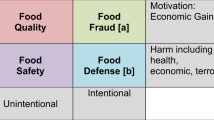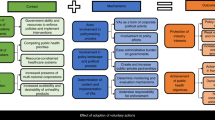Abstract
The history of food is replete with examples of food scandals leading to institutional and procedural reforms intended to rebuild trust. For trust to be sustainable, systems need to be trustworthy. Food regulatory institutions are at the interface of science and policy, and they should have robust and reliable mechanisms for identifying and addressing commercial conflicts of interest (COIs) among the membership of their boards and advisory committees. Here we provide a detailed estimate, analysis and critique of COIs within the United Kingdom’s food regulatory institutions. This exercise was facilitated by the United Kingdom’s rule requiring declarations of COIs, which are published. Institutions that require and publish declarations of COIs are probably more trustworthy than those that do not, while institutions that exclude all individuals with COIs could be even more trustworthy.
This is a preview of subscription content, access via your institution
Access options
Access Nature and 54 other Nature Portfolio journals
Get Nature+, our best-value online-access subscription
$29.99 / 30 days
cancel any time
Subscribe to this journal
Receive 12 digital issues and online access to articles
$119.00 per year
only $9.92 per issue
Buy this article
- Purchase on Springer Link
- Instant access to full article PDF
Prices may be subject to local taxes which are calculated during checkout
Similar content being viewed by others
Data availability
All the data used for this paper are in the public domain and identified in the references.
References
Macready, A. L. et al. Consumer trust in the food value chain and its impact on consumer confidence. Food Policy 92, 101880 (2020).
S Singh, B. K. et al. Enhancing science–policy interfaces for food systems transformation. Nat. Food 2, 838–842 (2021).
Eurobarometer Special Eurobarometer 354: Food-Related Risks (European Commission, 2010).
Food Safety Report No. COM(1999) 719 (Commission of the European Communities, 2000).
Millstone, E. Can food safety policy-making be both scientifically and democratically legitimated? If so, how? J. Agric. Environ. Ethics 20, 483–508 (2007).
Procedural Manual: Working Principles for Risk Analysis for Application in the Framework of the Codex Alimentarius 14th edn, 103–104 (Codex Alimentarius Commission, 2004).
Ibarreta Ruiz, D. (ed.) Risk-Assessment Policies: Differences across Jurisdictions EUR 23259 EN (European Commission, 2008).
EIT Food Trust Report (European Institute of Innovation and Technology, 2022).
Lacy-Nichols, J. & Williams, O. ‘Part of the solution’: food corporation strategies for regulatory capture and legitimacy. Int. J. Health Policy Manage. 10, 845–856 (2021).
Bernstein, M. H. Regulating Business by Independent Commission (Princeton Univ. Press, 1955).
Clare, K., Maani, N. & Milner, J. Meat, money and messaging: how the environmental and health harms of red and processed meat consumption are framed by the meat industry. Food Policy https://doi.org/10.1016/j.foodpol.2022.102234 (2022).
Lobbying in the 21st Century: Transparency, Integrity and Access (Organisation for Economic Cooperation and Development, 2021).
Sacks, G., Swinburn, B. A., Cameron, A. J. & Ruskin, G. How food companies influence evidence and opinion—straight from the horse’s mouth. Crit. Public Health 28, 253–256 (2018).
Ministry of Agriculture, Fisheries & Food The Food Standards Agency: A Force for Change Cm 3830 (Stationery Office, 1998).
Lang, T. & Millstone, E. P. Post-Brexit food standards. Lancet 303, 1199 (2019).
Lang, T., Millstone, E. & Rayner, M. Food Standards and the State: A Fresh Start (Centre for Food Policy (then Thames Valley University, now City University of London), 1997).
Triennial Review of the Six Food Standards Agency Scientific Advisory Committees (Food Standards Agency, 2016).
Summary Report of Stakeholders’ Responses (Food Standards Agency, 2018); https://www.food.gov.uk/sites/default/files/media/document/Consultation%20responses.pdf
Millstone, E. P. & Lang, T. Risking regulatory capture at the UK’s Food Standards Agency? Lancet 372, 94–95 (2008).
Member Profile: Ann Williams (Advisory Committee on the Microbiological Safety of Food, accessed 7 November 2022); https://acmsf.food.gov.uk/ann-williams
Steele, S., Ruskin, G., Sarcevic, L., McKee, M. & Stuckler, D. Are industry-funded charities promoting ‘advocacy-led studies’ or ‘evidence-based science’?: a case study of the International Life Sciences Institute. Global. Health https://doi.org/10.1186/s12992-019-0478-6 (2019).
Our Members (Advisory Committee on Animal Feedingstuffs, 2020); https://acaf.food.gov.uk/ACAFourmembers
Miles, E. Food we can trust—making it happen. New Food Magazine (12 August 2020).
Food Additives: A Balanced Approach (Ministry of Agriculture, Fisheries and Food, 1987).
van Zwanenberg, P. & Millstone, E. BSE: Risk, Science, and Governance (Oxford Univ. Press, 2005).
Right to Science in the Context of Toxic Substances Document ID A/HRC/48/61 (United Nations Human Rights Council, 2021); https://undocs.org/A/HRC/48/61
Sabatier, P. Social movements and regulatory agencies: toward a more adequate—and less pessimistic—theory of ‘clientele capture’. Policy Sci. 6, 301–342 (1975).
Nestle, M. Food Politics: How the Food Industry Influences Nutrition and Health 10th anniversary edn (Univ. of California Press, 2013).
Blair, T. A Journey (Random House, 2010).
Our Board (FSA, accessed 6 November 2022); https://www.food.gov.uk/about-us/our-board
Members of the FSA Board, Including Attendances Engagements and Expenses (FSA, accessed 6 November 2022); https://www.food.gov.uk/about-us/members-of-the-fsa-board-including-attendances-engagements-and-expenses
UK Expert Committee on Pesticides (GOV.UK, accessed 6 November 2022); https://www.gov.uk/government/groups/expert-committee-on-pesticides
ECP Members Biographies (GOV.UK, accessed 6 November 2022); https://assets.publishing.service.gov.uk/government/uploads/system/uploads/attachment_data/file/1065731/ecp-members-biographies.pdf
Veterinary Products Committee (GOV.UK, accessed 6 November 2022); https://www.gov.uk/government/organisations/veterinary-products-committee
Advisory Committee on Releases to the Environment (GOV.UK, accessed 6 November 2022); https://www.gov.uk/government/organisations/advisory-committee-on-releases-to-the-environment
ACRE Members Interests (GOV.UK, accessed 6 November 2022); https://assets.publishing.service.gov.uk/government/uploads/system/uploads/attachment_data/file/1044812/acre-members-interests.pdf
Science Council (FSA, accessed 6 November 2022); https://science-council.food.gov.uk/
Members of the ACNFP (ACNFP, accessed 6 November 2022); https://acnfp.food.gov.uk/ACNFPOurMembers
Our Members (ACMSF, accessed 6 November 2022); https://acmsf.food.gov.uk/our-members
Register of Interests (ACMSF, accessed 6 November 2022); https://acmsf.food.gov.uk/register-of-interests
COT Members (COT, accessed 6 November 2022); https://cot.food.gov.uk/COTmembers
Scientific Advisory Committee on Nutrition (GOV.UK, accessed 6 November 2022); https://www.gov.uk/government/groups/scientific-advisory-committee-on-nutrition#membership
SACN Register of Interests (SACN, accessed 6 November 2022); https://assets.publishing.service.gov.uk/government/uploads/system/uploads/attachment_data/file/1112738/SACN_Register_of_Interests_v34.pdf
Author information
Authors and Affiliations
Corresponding author
Ethics declarations
Competing interests
The authors declare no competing interests.
Peer review
Peer review information
Nature Food thanks Martin McKee and Stuart Gillespie for their contribution to the peer review of this work.
Additional information
Publisher’s note Springer Nature remains neutral with regard to jurisdictional claims in published maps and institutional affiliations.
Rights and permissions
Springer Nature or its licensor (e.g. a society or other partner) holds exclusive rights to this article under a publishing agreement with the author(s) or other rightsholder(s); author self-archiving of the accepted manuscript version of this article is solely governed by the terms of such publishing agreement and applicable law.
About this article
Cite this article
Millstone, E., Lang, T. An approach to conflicts of interest in UK food regulatory institutions. Nat Food 4, 17–21 (2023). https://doi.org/10.1038/s43016-022-00666-w
Received:
Accepted:
Published:
Issue Date:
DOI: https://doi.org/10.1038/s43016-022-00666-w
This article is cited by
-
The looming threat of profenofos organophosphate and microbes in action for their sustainable degradation
Environmental Science and Pollution Research (2024)



